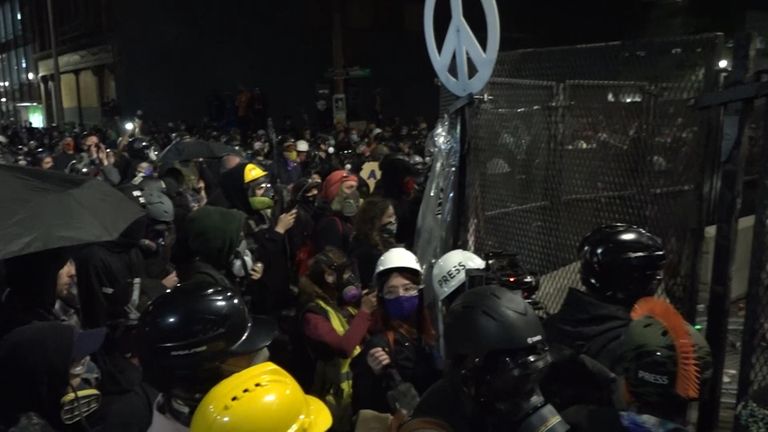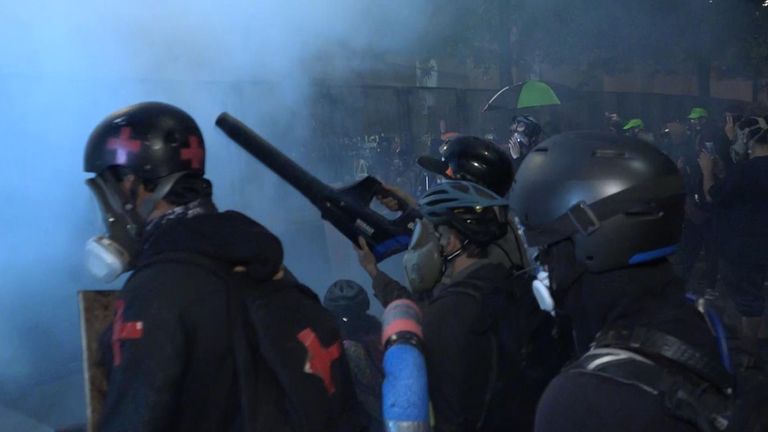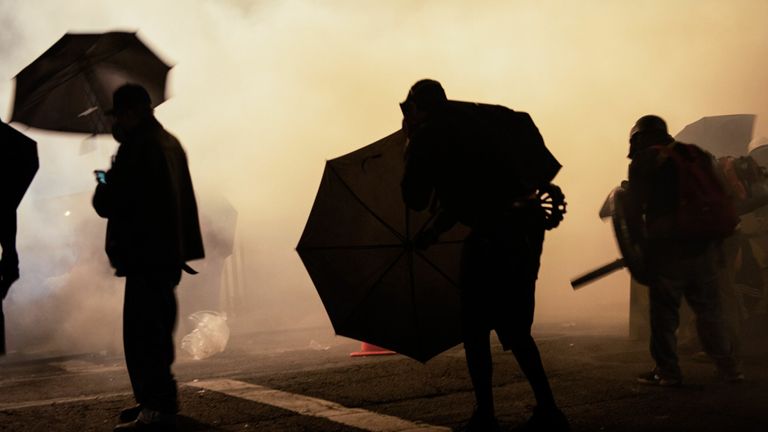Portland: A city under siege, overrun with anarchists? It's a far more complex picture
The only common ground in this complex picture is that no one can see how it is going to end.
By Sally Lockwood, correspondent in Portland, Oregon
SKY NEWS (A MURDOCH COMPANY0
Sunday 26 July 2020 UK

Image:A demonstrator is detained at an anti-racism protest in Portland, Oregon
There is nothing straightforward about what is happening here in Portland.
After the arrival of federal troops this month it has morphed into something else.
There are still thousands of people who protest peacefully in support of Black Lives Matter each evening. But as night falls, a crowd surrounds the federal courthouse. Among them, a violent contingent who lob fireworks and push against the temporary metal fence separating the troops and the public.

There is nothing straightforward about what is happening here in Portland.
After the arrival of federal troops this month it has morphed into something else.
There are still thousands of people who protest peacefully in support of Black Lives Matter each evening. But as night falls, a crowd surrounds the federal courthouse. Among them, a violent contingent who lob fireworks and push against the temporary metal fence separating the troops and the public.

Image:Federal police are guarding the courthouse in downtown Portland


Image:For 11 nights tear gas and rubber bullets have been fired back at protesters
For 11 nights tear gas and rubber bullets have been fired back at protesters. But their response is well-coordinated, repelling the CS gas with leaf blowers, the bullets with homemade shields.
There are troublemakers here, there's no question. Some who clearly seek to antagonise and hurt the federal troops. They're not the majority but images of this violence support Donald Trump's narrative that this is a city under siege, overrun with anarchists.
The reality is very different, the picture far more complex.
Day to day life for most people has not changed, with the unrest confined to a few square blocks in the city centre.
Peaceful protesters are still by far the biggest demographic here, on the streets each evening to protest racial injustice. But after the president deployed federal troops earlier this month to protect monuments and federal property, more people have gathered to protest against their presence in the city. As many peaceful protesters leave at night, the remaining crowd gets more angry and some violent.
Opposite the federal courthouse, a park has now become a protest camp. Even here the picture is complex - mixed with the protesters are the homeless, drug addicts, and the mentally ill. A traffic cone, thrown in broad daylight at an unmarked police car, triggered a rapid response from federal police. A fragile stand-off followed between the protest camp and federal officers. Some chanted "Feds go home", others hurled abuse. It felt volatile, like it could kick off at any moment.
A young black man appointed himself mediator and bravely stood between the protesters and federal agents. The mere sight of him appealing to officers was worrying but the conversation went well and the situation was defused. The man told me he had explained the person who threw the traffic cone suffered from bipolar disorder. Without his involvement it could have ended very differently. The arrival of federal officers on the scene antagonised protesters who responded by shouting abuse. It feels on a knife edge.

For 11 nights tear gas and rubber bullets have been fired back at protesters. But their response is well-coordinated, repelling the CS gas with leaf blowers, the bullets with homemade shields.
There are troublemakers here, there's no question. Some who clearly seek to antagonise and hurt the federal troops. They're not the majority but images of this violence support Donald Trump's narrative that this is a city under siege, overrun with anarchists.
The reality is very different, the picture far more complex.
Day to day life for most people has not changed, with the unrest confined to a few square blocks in the city centre.
Peaceful protesters are still by far the biggest demographic here, on the streets each evening to protest racial injustice. But after the president deployed federal troops earlier this month to protect monuments and federal property, more people have gathered to protest against their presence in the city. As many peaceful protesters leave at night, the remaining crowd gets more angry and some violent.
Opposite the federal courthouse, a park has now become a protest camp. Even here the picture is complex - mixed with the protesters are the homeless, drug addicts, and the mentally ill. A traffic cone, thrown in broad daylight at an unmarked police car, triggered a rapid response from federal police. A fragile stand-off followed between the protest camp and federal officers. Some chanted "Feds go home", others hurled abuse. It felt volatile, like it could kick off at any moment.
A young black man appointed himself mediator and bravely stood between the protesters and federal agents. The mere sight of him appealing to officers was worrying but the conversation went well and the situation was defused. The man told me he had explained the person who threw the traffic cone suffered from bipolar disorder. Without his involvement it could have ended very differently. The arrival of federal officers on the scene antagonised protesters who responded by shouting abuse. It feels on a knife edge.

Image:Neither side is showing any sign of backing down in Portland
Even during the day some of the scenes in Portland are surreal. In the early afternoon I see a protester running through the streets dragging a table, followed by a police car. As they reach the traffic lights they stop to yell at a police car following at a safe distance. Their destination is the federal court house, where they tell me they've been protesting with the group Riot Ribs since 30 May.
In the constant melee outside the courthouse I spot two men on the periphery who look out of place. The father and son have driven from Sandy, around 30 miles away, to see what's going on. Both voted for Donald Trump at the last election and plan to vote for him again in November. "They should just disperse them. Get it done," the father, Randy, tells me. "The election is where this ends. If he takes over the house and senate then this is going to escalate, huge." I ask if that's what he wants to happen. "No. No. I want Trump to win and I want this to go away. And if Biden wins I think it'll go away because they're going to get what they want."
Away from the square, the volatile epicentre of this unrest, I seek views from local people who aren't involved in the demonstrations. One government worker walks with me as he carries his groceries home. I ask him how he feels about what he's seeing in his city. "If the federal agents weren't here, a lot of the protesters wouldn't be either," he says. "I'm happy that people want to get out and make their voices heard because most Americans are super complacent."

Even during the day some of the scenes in Portland are surreal. In the early afternoon I see a protester running through the streets dragging a table, followed by a police car. As they reach the traffic lights they stop to yell at a police car following at a safe distance. Their destination is the federal court house, where they tell me they've been protesting with the group Riot Ribs since 30 May.
In the constant melee outside the courthouse I spot two men on the periphery who look out of place. The father and son have driven from Sandy, around 30 miles away, to see what's going on. Both voted for Donald Trump at the last election and plan to vote for him again in November. "They should just disperse them. Get it done," the father, Randy, tells me. "The election is where this ends. If he takes over the house and senate then this is going to escalate, huge." I ask if that's what he wants to happen. "No. No. I want Trump to win and I want this to go away. And if Biden wins I think it'll go away because they're going to get what they want."
Away from the square, the volatile epicentre of this unrest, I seek views from local people who aren't involved in the demonstrations. One government worker walks with me as he carries his groceries home. I ask him how he feels about what he's seeing in his city. "If the federal agents weren't here, a lot of the protesters wouldn't be either," he says. "I'm happy that people want to get out and make their voices heard because most Americans are super complacent."

Image:Unrest is confined to a few square blocks in the city centre
A hotel worker who doesn't attend the protests either tells me he supports a lot of the reasons behind the demonstrations, despite the financial impact it's having on business. He tells me he has been affected by the tear gas at work after three canisters were deployed in the street outside. "I had to go and deliver sheets to a guest's room after being tear gassed," he says. "The reality is before the feds arrived the protests had dropped to around 100 hardcore people. The big marches had stopped and it had calmed down. Now look."
The presence of federal troops in Portland has upset many, even some who aren't demonstrating. The government has the right to protect federal buildings but it's very unusual for an administration to send in law enforcement without an invitation from local officials and the local police. That is what has happened here and this is what has made so many people so angry. The mayor of Portland and the governor of Oregon have said they're not welcome. One of the state's senators has said America is staring down the barrel of martial law.
Meanwhile, the intense stand-off between federal troops and protesters is entering a 12th night. Neither side is showing any sign of backing down - if anything they're upping the ante. It feels increasingly dangerous.
The only common ground I've found in this complex picture is that no one can see how it is going to end.
A hotel worker who doesn't attend the protests either tells me he supports a lot of the reasons behind the demonstrations, despite the financial impact it's having on business. He tells me he has been affected by the tear gas at work after three canisters were deployed in the street outside. "I had to go and deliver sheets to a guest's room after being tear gassed," he says. "The reality is before the feds arrived the protests had dropped to around 100 hardcore people. The big marches had stopped and it had calmed down. Now look."
The presence of federal troops in Portland has upset many, even some who aren't demonstrating. The government has the right to protect federal buildings but it's very unusual for an administration to send in law enforcement without an invitation from local officials and the local police. That is what has happened here and this is what has made so many people so angry. The mayor of Portland and the governor of Oregon have said they're not welcome. One of the state's senators has said America is staring down the barrel of martial law.
Meanwhile, the intense stand-off between federal troops and protesters is entering a 12th night. Neither side is showing any sign of backing down - if anything they're upping the ante. It feels increasingly dangerous.
The only common ground I've found in this complex picture is that no one can see how it is going to end.
No comments:
Post a Comment